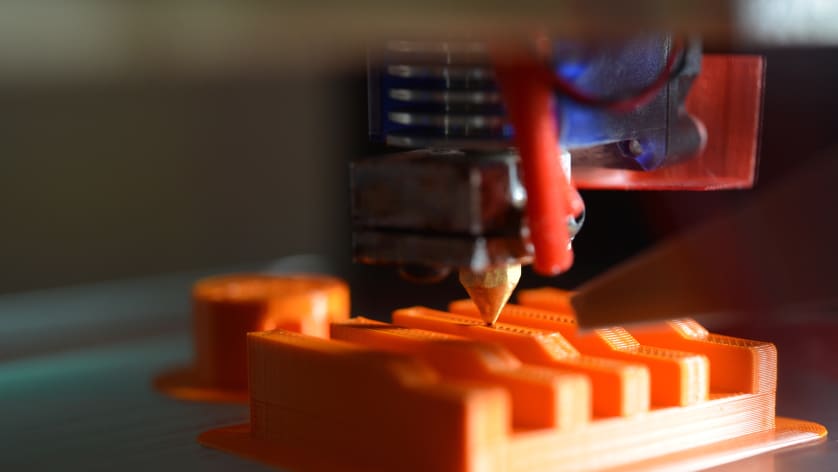How Does 3D Printing Work?

3D printing is an efficient and cost-effective way to create solid, three-dimensional objects from a digital file. It has revolutionized the manufacturing industry. The field of 3D printing has grown exponentially since then and now holds countless possibilities.
3D printing, also known as additive manufacturing, is a process that creates objects layer by layer from a digital model.
The 3D printing industry is expected to grow to a value of $84 billion by 2029.
What is 3D printing?
3D printing or additive manufacturing is a process of making three dimensional solid objects from a digital file. The creation of a 3D printed object is achieved using additive processes. In an additive process an object is created by successively adding material layer by layer.
3D printing is also disrupting the healthcare industry. In 2020, the COVID-19 pandemic overwhelmed hospitals and increased the need for personal protective equipment. Healthcare facilities have increasingly relied on 3D printing technology to produce essential protective equipment and ventilator components during the pandemic. The usage of 3D printing will result in changes not only for the creation of PPE and medical equipment, but also in the prosthetics and implants industry.
As many people still don't know how 3D printing works, here is a guide to understanding it.
What Are 3D Printers?
In short, 3D printers use CAD to create three-dimensional objects from a variety of materials, like molten plastic or powders. 3D printers come in a wide range of shapes and sizes, from those small enough to fit on a desk to large-scale construction models used in the making of 3D-printed houses.
TYPES OF 3D PRINTERS
Stereolithographic, or SLA printers, are equipped with a laser that forms liquid resin into plastic.
Selective laser sintering, or SLS printers, have a laser that sinters particles of polymer powder into an already solid structure.
Fused deposition modeling, or FDM printers, are the most common. These printers release thermoplastic filaments that are melted through a hot nozzle to form an object layer by layer.
3D printers are not like the magical boxes seen in sci-fi movies; instead, they use a layering method to create the desired object. They start from the bottom and work their way up, adding layer after layer until the object looks exactly as they imagined it.
Why Are They Important for the Future?
3D printers offer flexibility, accuracy, and speed, making them a promising tool for future manufacturing.
The use of 3D printers by companies for prototyping can save months of time and millions of dollars in research and development costs. It has been claimed by some businesses that 3D printers make the prototyping process ten times faster and five times cheaper than the traditional methods of research and development.
But they can be used for much more than prototyping. 3D printers are being used in schools to provide hands-on learning opportunities for students by printing three-dimensional dinosaur bones and robotics pieces. The flexibility and adaptability of 3D printing technology means it can revolutionize any industry it is adopted in.
What Can You 3D Print?
3D printers have a lot of flexibility for what can be printed with them. For example, they can use plastics to print rigid materials, like sunglasses. They can also create flexible objects, using a hybrid rubber and plastic powder. Three-dimensional printers have the ability to print with carbon fiber and metallic powders to create extremely strong industrial products.
Fast Manufacturing
This method of printing is efficient and provides a way for companies to test products before they go into full development, without the need for extra expensive models or tools. 3D printing technology is increasingly being used for rapid manufacturing, which can save costs when producing small batches or short runs of custom-made products.
Functional Parts
3D printing technology has become more functional and precise, making it possible to create and acquire parts that would otherwise be proprietary or inaccessible. Additionally, machines and devices wear down over time and may require repair. 3D printing provides a streamlined solution to this problem.
Tools
Like functional parts, tools also experience wear and tear over time, which may make them inaccessible, obsolete or expensive to replace. 3D printing provides a convenient and cost-effective solution for replacing tools for multiple applications with high durability and reusability.
Models
Although 3D printing cannot replace all forms of manufacturing, it can be used to create models for visualization, which is less expensive than other methods. As the cost of 3D printing falls and accessibility increases, a range of new modeling opportunities are being made available, such as consumer product visualizations, architectural models, medical models, and educational tools.
HOW DOES A 3D PRINTER WORK?
Additive manufacturing, of which 3D printing is a part, uses similar methods to traditional inkjet printers to create three-dimensional objects. Additive manufacturing, also known as molding and 3D printing, is a process of creating something in layers by adding material continuously until the final design is complete.
The main steps that 3D printers take to bring ideas to life are using a combination of software, powder-like materials and precision tools.
3D printers use computer-aided design to create three-dimensional objects. Once a design is completed, a material that can be dispensed through a hot nozzle or precision tool can be printed layer by layer in order to create a three-dimensional object from scratch.
3D Modeling Software
In order to achieve maximum precision, the first step of any 3D printing process is 3D modeling. This is because 3D printers cannot magically guess what it is that you want to print, and therefore, all objects must be designed using a 3D modeling software. Some designs are too intricate for traditional manufacturing methods; CAD software provides a solution.
3D printing technology is transforming many industries by allowing for unprecedented levels of customization and precision in product design. This modeling software is very important to an industry like dentistry, where labs use 3D software to design teeth aligners that fit precisely to the individual. Its importance to the space industry cannot be understated, as they use the software to design some of the most delicate aspects of a rocketship.
Slicing the Model
3D printers cannot conceptualize three dimensions like humans, so engineers need to slice the model into layers for the printer to create the final product.
Slicing software provides instructions to 3D printers that tell them how to move in order to recreate a scanned model layer by layer. This filling provides 3D printed objects with internal lattices and columns that help shape and strengthen the object. Once the model is sliced, it is sent off to the 3D printer for the actual printing process.
The process
After the modeling and slicing of a 3D object is completed, it is time for the 3D printer to begin printing. In the direct 3D printing process, a printer nozzle moves back and forth while dispensing a wax or plastic-like polymer layer-by-layer, waiting for each layer to dry before adding the next one, in a manner similar to traditional inkjet printers. By adding hundreds or thousands of 2D prints on top of each other, it creates a three-dimensional object.
3D Printing Materials
Different materials are used by printers to create an object that is as close to the original as possible:
Acrylonitrile Butadiene Styrene (ABS)
A material that is easy to shape and tough to break, typically used in toys such as LEGOs.
Carbon Fiber Filaments
Carbon fiber is used to create objects that need to be strong, but also extremely lightweight.
Conductive Filaments
These printable materials, still in the experimental stage, can be used to print electric circuits without the need for wires. This is a useful material for wearable technology.
Flexible Filaments
These materials can be used to print a variety of objects, ranging from wristwatches to phone covers.
Metal Filament
Metal filaments are made of finely ground metals and polymer glue. They can come in steel, brass, bronze and copper to get the true look and feel of a metal object.
Wood Filament
These filaments are made of finely ground wood powder mixed with polymer glue, allowing you to print wooden-looking objects that can appear lighter or darker depending on the temperature of the printer.
The 3D printing process usually takes a few hours for simple prints, but it can take days or weeks for more complicated prints, like a full-sized replica of a house.
How much does such a printer cost?
The cost varies based on size, quality, specialty and use. The lowest level of printers starts at about 100 dollars, the industrial models can set a company back a whopping 100.000 dollars. In the middle, mid-tier models can cost between 2000 and 5000 dollars.
3D Printing Processes and Techniques
The size, detail and scope of a project will dictate the type of 3D printer used. Every printer prints a little differently.
Fused Deposition Modeling (FDM)
Fused deposition modeling (FDM) is a 3D printing technology that is widely used for manufacturing prototypes and models with plastic.
Stereolithography (SLA) Technology
SLA printing is a type of 3D printing that is best suited for intricate prints with high detail.
Digital Light Processing (DLP)
DLP is one of the oldest forms of 3D printing, which uses lamps to produce prints at higher speeds than SLA printing because the layers dry in seconds.
Continuous Liquid Interface Production (CLIP)
The CLIP process utilises Digital Light Synthesis technology to project a sequence of UV images across a cross-section of a 3D printed part, resulting in a precisely controlled curing process.
Material Jetting
Material Jetting is a process of depositing droplets of material through a small diameter nozzle to build a platform, which becomes hardened by UV light.
Binder Jetting
The binder jetting process involves the use of a powder material and liquid binder, which are applied through jet nozzles to adhere the powder particles together.
Fused Deposition Modeling (FDM)
In fused filament fabrication (FFF), also known as Fused Filament Fabrication (FFF), a plastic filament is unwound from a spool and flowed through a heated nozzle in horizontal and vertical directions. The object is formed immediately as the melted material hardens.
Selective Laser Sintering (SLS)
A type of Powder Bed Fusion, SLS fuses small particles of powder together by use of a high-power laser to create a three-dimensional shape. The laser scans each layer on a powder bed and selectively fuses them, then lowering the powder bed by one thickness and repeating the process through completion.
Multi-Jet Fusion (MJF)
MJF uses a powder bed and an inkjet-equipped arm to deposit binder selectively. Direct Metal Laser Sintering also utilizes the same process, but with metal powder specifically.
Sheet Lamination
Sheet lamination is a process that binds material in sheets together through external force and welds them together through layered ultrasonic welding.
Directed Energy Deposition
Directed Energy Deposition (DED) is a 3D printing process that uses a robotic arm to apply metal powder to a surface.
3D PRINTING EXAMPLES
3D printing is becoming increasingly popular and is offering innovative solutions to challenges all over the world.
3D PRINTING USES
- Construction
- Automotive
- PPE
- Medical Equipment
- Food
- Aerospace
- Education
3D Printed Food
3D printed food is something that seems like it would be out of a cartoon or too good to be true. Using a process similar to that seen in sci-fi shows, 3D printers can layer on real pureed ingredients to create the foods we know and love.
As long as the printer is cleaned and working properly, 3D printed food is safe to eat. Detailed chocolate printing, for example, may take 15 to 20 minutes. Seemingly long, we’ve nonetheless seen printers use this technology to create burgers, pizza, gingerbread houses, and more.
3D Printed Houses
New Story, a nonprofit dedicated to creating better living conditions, built the first 3D-printed community in Mexico. New Story is able to use a 33-foot long printer to churn out a 500 square-foot home, complete with walls, windows and two bedrooms in just 24 hours.
3D Printed Organs and Prosthetic Limbs
In the future, 3D printers will be able to create working organs for those who need transplants. Instead of the traditional organ donation process, doctors and engineers are teaming up to develop the next wave of medical technology that can create organs from scratch. Organs are first 3D modeled in this process, using the exact specifications of the recipient’s body. Then, a combination of living cells and polymer gel (better known as bioink) are printed off layer-by-layer, in order to create a living human organ. This technology has the ability to change the medical industry and reduce the number of patients on the organ donation waitlist in the United States.
3D printing is a revolutionary means of improving quality-of-life for patients while making solutions more accessible to healthcare providers. The technology has even fast-tracked production and durability of prosthetics while reducing costs.
3D Printed Aerospace Technology
What do you think the future of space travel will be? This company, Relativity Space, claims to be able to 3D print a working rocket in as little as a few days- using one hundred times fewer parts than what is needed for a traditional shuttle. The company's first conceptualized rockets, the Terran 1 and Terran R, will only take 60 days from the start of printing to the launch into space.
3D printing is a more efficient way of manufacturing, resulting in lower costs and quicker production times. It can also reduce the amount of parts that need to be welded together. The LEAP engine from GE Aviation is another example of something that uses 3D printed Cobalt-chrome fuel nozzles.
3D Printed Cars
3D printing has been used in the automotive industry for many years, allowing companies to shorten design and production cycles while reducing the amount of inventory required. 3D printing provides a way to customize vehicles or restore old cars with parts that are no longer in production.
3D Printed Consumer Products
Consumer products that do not have a digital or electronic build quality, such as clothing, eyewear, jewelry, etc., can all be mass-produced through 3D printing. 3D printing can be used to create products with a body or frame that would otherwise be difficult or impossible to create through traditional manufacturing methods.
Advantages of 3D printing
Affordability
3D printing technology has the potential to revolutionize the manufacturing process by making it more streamlined and efficient. The accessibility of materials also contributes to the affordability of 3D printing; for example, low-cost plastics and concrete can be used.
Fast
It is very quick for prototyping because it can be done in-house. Also, you can easily fix mistakes and just print the object again, without having to order it in from another company.
Special materials
Although plastics and metals are commonly used in the 3D printing industry, there are other material options available that offer advantages for specific applications. Speciality materials such as this one allow for properties such as high heat resistance, water repellency and strength.
Disadvantages of 3D printing
Lack of stability/strength
One downside to building an object up in layers is that it can weaken the object's overall strength and durability.
Accuracy
Despite the fact that CAD is frequently an accessible and precise method to design, there can be mistakes. Exactness with 3D printing is subject to the strategies and printers use. For example, some smaller 3D printers, like desktop models, can have lower production quality than larger models. This means that as the production of a design goes on, the products made later on may vary from the first batch.
Requires post-processing
Another disadvantage of 3D printing is the additional work that might be required to finish a product, such as sanding or smoothing out an object, heat treatment or removing support struts.


















